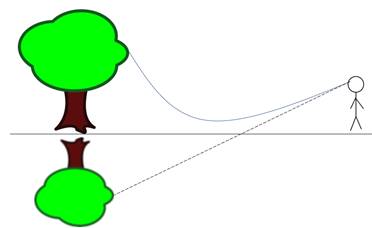The phenomena involved in the reflection of radio waves by ionosphere is similar to
When radio waves travel in up in the atmosphere, they undergo subsequent refractions away from the normal as the optical density of air keeps on reducing (in general). At the ionosphere, they reach the critical angle. Then, there is total internal reflection. Now, the radio wave is travelling downward and undergoing subsequent refractions. The radio wave subsequently moves towards the normal as the optical density of air increases as it goes towards the earth.
Option (a): Reflection by a mirror doesn’t involve subsequent refractions. Moreover, purely reflection is achieved by blocking the path of refracted ray (polishing the glass) rather than by light being incident at more than critical angle. Thus, (a) is unlikely to be correct.
Option (b):
Formation of a rainbow involves refraction of light when entering
Let us see how a mirage is formed. Warmer air has less refractive index than cooler air. On a hot day, air near the ground is hotter than above. Refractive index decreases progressively towards the ground. Light emanating from an object bends away from the normal progressively. At one point, the angle of incidence is large enough to cause total internal reflection. This results into inverted image to be formed on the ground of the light source. This gives the illusion of water.

This is a smaller and inverted version (also, different wavelength of light) of total internal reflection of radio waves in the ionosphere. Thus, option (b) seems like a good match.
Option (c):
Sunlight goes through refraction and dispersion when entering a water droplet. This is followed by total internal reflection inside the droplet. Then, light refracts as it emerges out of the droplet. This causes the formation of a rainbow. This is quite different than the situation given. Hence (c) is probably incorrect.
Option(d):
A light beam is scattered in different directions by fine particles. But scattering has nothing to do with reflection of radio waves. Hence, (d) is clearly incorrect.
Looking at all the options, the best match is option (b).